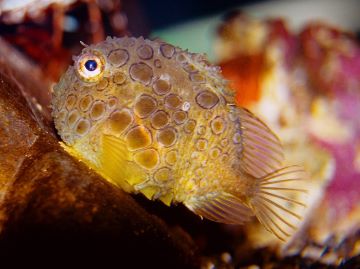4_Lumpsucker_edit.jpg

The Pacific spiny lumpsucker has a modified fin that it uses to adhere to substrate, and the rest of its body is covered in spiny plates of armor. Credit: David Csepp, NMFS/AKFSC/ABL.
Judging by its name alone, you might expect the Pacific spiny lumpsucker to be a fearsome creature. But divers often describe the fish as cute and comical. They’re small and round, they don’t swim well, and they’ll even eat from a diver’s hand. So, despite the name, the Pacific spiny lumpsucker is nothing to fear.
The fish is typically no more than an inch or two across. It’s found near the coast from Washington State to northern Japan. It lives mainly in shallow waters close to shore.
Two of its fins form a sucker like those on the arms of an octopus. The fish uses them to anchor itself to rocks or other solid objects on the sea floor. It then patiently sits and waits for slow prey to amble by.
The lumpsucker is a little more fearsome when you look at it up close. It has sharp teeth, a mohawk-like fin on its head, and spikes all over its body. Because it stays still, it’s often covered with algae, which offers a type of camouflage. And a recent study found that it can glow red to match the color of the algae.
Lumpsucker scales aren’t scales at all—they’re body armor. They’re made from a type of enamel found in teeth. A young lumpsucker starts with the enamel only around its mouth. As it ages, the material quickly grows to cover the rest of its body, all the way to the tail. That provides protection against predators, and against the buffeting of waves close to shore—the dangers that face the fearsome-sounding but harmless little creature.

